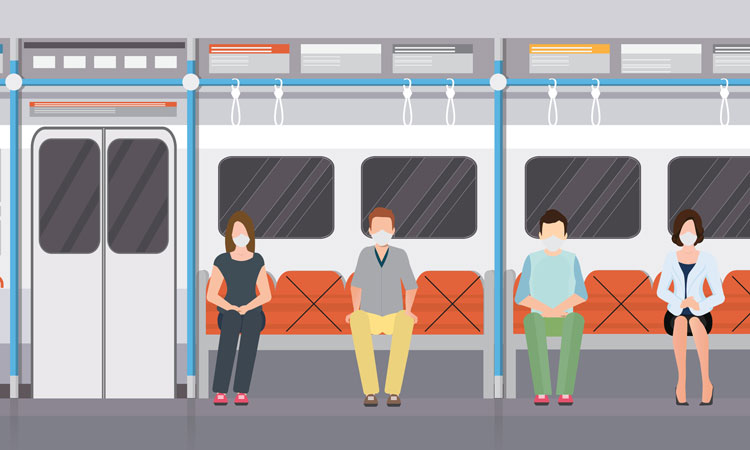Keeping the human centric approach as the UK plans to reopen its railways
Posted: 11 May 2020 | Tom Meacock | No comments yet
Tom Meacock, Client Director, Strategic Rail at Atkins, looks at the critical issues facing the rail sector as we look to the ‘new normal’ and how might we respond to them.


The global pandemic has resulted in challenges on a scale previously never encountered – from healthcare systems strain, travel restrictions, deep economic impacts, loss of life and effects on social behaviour and mental health. Our way of living has drastically changed over the last few months, resulting in an overall 80-90 per cent reduction in travel demand.
Network Rail and train operating companies have the challenge of planning how to prevent the spread of COVID-19 while dealing with the inevitable increase in passenger numbers
Our rail workers have kept the railways going during unprecedented times, and the process of reopening our transport links to support any reopening of the economy will need to be based on monitoring, strict hygiene levels and clear information so our passengers and staff feel comfortable and safe. While the public continue to be advised not to travel on public transport, Network Rail and train operating companies have the challenge of planning how to prevent the spread of COVID-19 while dealing with the inevitable increase in passenger numbers, as people start to return to work following the government’s phased plan to reopen society.
A programme approach will be required to implement safety measures and interventions across the railway to support this plan; one which will need to flex over time as more people use the system and best practice evolves. Most importantly the programme can only be successful when people follow the rules and look out for each other. The UK lockdown has seen communities come together in a multitude of ways – and safe rail travel will depend on passengers’ buy-in to address concerns about safety, distances, and service provision.
So, what are the critical issues facing the rail sector as we look to the ‘new normal’ and how might we respond to them?
- Social distancing – passengers must feel safe and secure that social distancing measures are being upheld, and they have enough space to move about their journeys
- Cleaning and hygiene – higher frequencies of cleaning will be required
- Safety information delivery – information must be regular, up to date, consistent and clear
- Passenger flow management – due to social distancing, footfall of passengers on trains and specific flows around stations should be clearly managed and communicated
- Operational capacity – operations must be maintained, with regular service that takes the above factors into account.
Moving about safely on our trains and station platforms
Understandably at first passengers and staff could feel anxious about close proximities on platforms, forecourts and train carriages. It will be key that passengers and staff know where to walk and stand and be most comfortable in a new situation.
We must realise safe standing and seating areas on every train and platform, according to government guidelines.
We must realise safe standing and seating areas on every train and platform, according to government guidelines. On stations this could be done with social distance stickers on platforms, dynamic passenger flows around stations and digital wayfinding signage to support segregated movement of people wherever possible. And on trains: identifying safe standing and seated zones with tape, seat covers, safe zones, and always keeping all walkways clear. We should also plan for a continued suspension of refreshment services.
All passengers could be required to move through carriages according to a one-way system. Such a system would include mandatory designated entrance and exit doors, clear signage and instructions, automatic doors to limit contamination on push buttons, and systems to allow sequenced boarding, alighting and dynamic timetabling.
Maintaining fresh air and highest hygiene standards
To maintain a consistent fresh air supply and keep our surroundings safe, we could modify existing air conditioning systems on trains and increase air flows. Surfaces should be coated to mitigate any risks of the virus spreading, and deep cleans carried out at a higher frequency than previously done. This also applies to hand sanitiser dispensers being readily available at multiple strategic locations.
Keeping check through programming, signage and monitoring
Underpinning all measures will need to be clear communication across the railway’s operations. These should include COVID-19 warning signage throughout trains and seat covers with clear and unambiguous social distancing and luggage stowage guidelines.
Underpinning all measures will need to be clear communication across the railway’s operations.
Yet signage will not be enough; Passenger Information Systems should be used to provide frequent audible and visual warnings, with information boards and digital screens at stations – so often used for advertising – re-programmed to promote safe travel guidelines.
Digital technology can also support efforts, helping to count passengers, monitor passenger flows, densities of people within stations and detect pinch points. We will rely on data monitoring to improve and develop service efficiency and manage crowds and areas of high risk.
To recap, top measures will focus on:
- Safety – maintenance and operational staff, passengers
- Control, command, communication, monitoring with dynamic response systems
- Passenger health – monitoring and screening at station entry
- Management – safety and security check-points.
The human centric approach means winning the hearts and minds, and trust of our passengers.
The human centric approach means winning the hearts and minds, and trust of our passengers. It’s about helping people understand what they should be doing, where and when, and influencing their behaviour at every point of a journey. For example, while trains are unable to run at full capacity, we must assist passengers to make decisions on travel times or potential changes to start and end stations to smooth the flow of people on the system.
From route planning, to entering a station, and continuing onward journeys into cities, queues for office blocks, or taking local transport, these measures across the rail industry will impact the wider infrastructure and transport environments. It’s up to us all to make sure everyone feels confident to carry out every journey safely and efficiently, no matter how they’re travelling.


Related topics
Coronavirus/COVID-19, Passenger Experience/Satisfaction, Passenger Information Systems (PIS), Regulation & Legislation, Safety, The Workforce








